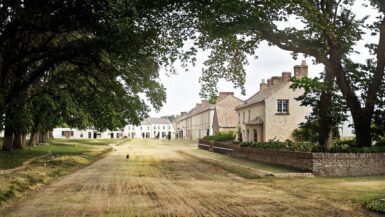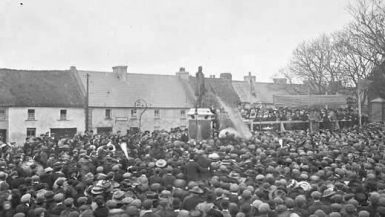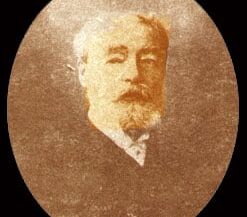ABBEY, a parish, in the poor-law union of Ennistymon, barony of Burren, county of Clare, and province of Munster; containing, with the post-village of New Quay, 1442 inhabitants. This place, which is situated on the road from Galway to Ennistymon. and on the shores of the harbour of New Quay or Murticlough, at one time called Burren, in the bay of Galway, derives its name from an ancient Cistercian abbey founded here, either by Donald O’Brien, King of Limerick, in 1194, or by his son Donough Carbrac O’Brien, in the year 1200. This establishment, designated the abbey of Corcomroe, Corcomroadh, or De Petra fertili, and called also Glanamanagh, or “the Glen of the Monks,” is said to have been a sumptuous edifice, dedicated to the Blessed Virgin, and dependent on or connected with the abbey of Suirc, or Innislaunaght, in the comity of Tipperary. It was afterwards made subject to the celebrated abbey of Furness, in Lancashire, and had a cell annexed to it in Kilshanny, in the adjoining barony of Corcomroe. The remains are extensive, forming an interesting object as seen from the road, and presenting evident traces of former splendour: a fine pointed arch, still tolerably perfect, is particularly admired for the beauty of its proportions j and there are some remains of the tomb of the King of Thomond, who was killed in a battle near this place, in 1267.
The parish extends along the southern shore of the bay, on the confiues of the county of Galway, and comprises 4714 1/2 statute acres. The greater portion is under tillage ; the land along the coast produces good crops of wheat and potatoes, but that in the interior is hilly and unproductive, adapted only for grazing sheep, The system of agriculture has been greatly improved through the exertions of Burton Bindon, Esq., and Messrs. Hynes and Moran. The bed of the entire soil, and also the hills, are one uninterrupted mass of limestone ; and two quarries, close to the village of Murticlough, are resorted to for stone for building : sea manure is found in abundance on the shore. The small port of New Quay, or Deepharbour, is situated about a quarter of a mile to the north of the village of Murticlough ; a constant intercourse is kept up with Galway, on the opposite side of the bay, and a considerable trade in corn it carried on. The port affords great facilities for commerce, as vessels of large burthen can approach at any time of the tide. The coast is well adapted for bathing. The oyster bed called the Red Bank, to the east of Murticlough, and said to be one of the most extensive on the Irish coast, was established some years since by Mr. Bindon, and is now in great celebrity; it is stocked with young oysters, chiefly from Connemara, and more than 150 persons, chiefly women and children, are regularly employed. A tolerable trade is also carried on in sea-weed with the farmers of the interior, which has greatly increased since the construction of the line of road leading from the confines of the county of Galway into the interior and along the coast of the county of Clare. The harbour of New Quay is one of the several inlets of the bay of Galway , it lies to the south of Aughnish Point, and extends four miles up to Curranroe Bridge. The late Fishery Board built a small quay in the narrow part of the channel, at the village of New Quay (so called from the construction of this quay, about twenty years since), a little to the east of an older one, of which there are still some remains: vessels of 100 tons can come close up to it and deliver their cargoes. A court is held at Curranroe, or Curranruc, by a stipendiary and one or more resident magistrates, about once in six weeks, for the recovery of small debts: at New Quay is a constabulary police station.
Abbey is in the diocese of Kilfenora, and is a rectory, partly without provision for cure of souls: the tithes, with the exception of those of the townlands of Aughnish, Finvarra, Behagh, and Kilmacrane, which are annexed to the parish of Kilcorney, are impropriate in Pierse Creagh, Esq., and the rent charge is £90. In the Roman Catholic divisions Abbey is the head of a district comprising also the parish of Oughtmanna; the chapel is situated in the village of Behagh. About half a mile to the west of Corcomroe, is an interesting ruin, built of huge wedge-formed stones, laid with the thin edge towards the thick, so as to present an exact oblong, or nearly so. On the summit of Rosala mountain is a well, dedicated to St. Patrick, springing from the solid rock, and producing water of the purest quality, supposed to be efficacious in the cure of sore eyes, headache, &c. : a lower spring is conveyed by pipes to the road side at the foot of the mountain. —See Murticlough.
Extract from: Lewis – A Topographical Dictionary of Ireland





Leave a reply